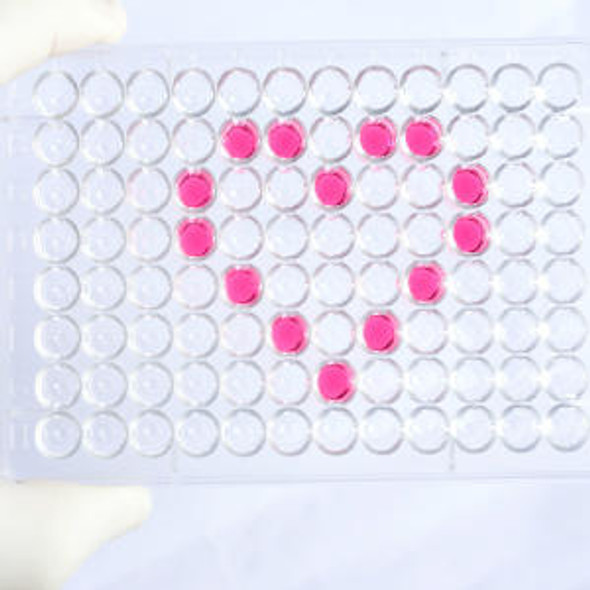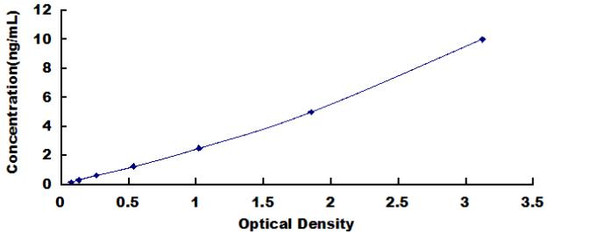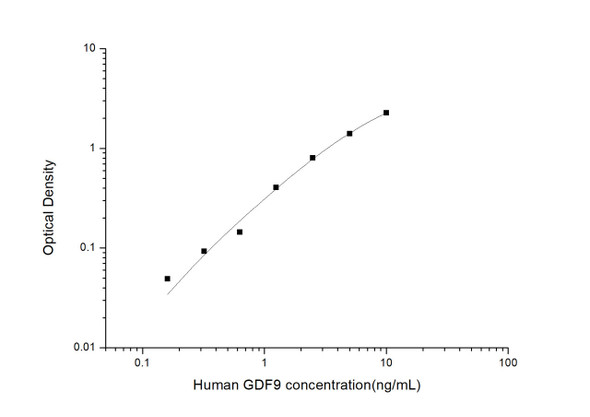Human Cell Biology ELISA Kits 5
Human GDF9 (Growth Differentiation Factor 9) CLIA Kit (HUES01057)
- SKU:
- HUES01057
- Product Type:
- ELISA Kit
- ELISA Type:
- CLIA Kit
- Size:
- 96 Assays
- Sensitivity:
- 18.75pg/mL
- Range:
- 31.25-2000pg/mL
- ELISA Type:
- Sandwich
- Reactivity:
- Human
- Sample Type:
- Serum, plasma and other biological fluids
- Research Area:
- Cell Biology
Description
| Assay type: | Sandwich |
| Format: | 96T |
| Assay time: | 4.5h |
| Reactivity: | Human |
| Detection method: | Chemiluminescence |
| Detection range: | 31.25-2000 pg/mL |
| Sensitivity: | 18.75 pg/mL |
| Sample volume: | 100µL |
| Sample type: | Serum, plasma and other biological fluids |
| Repeatability: | CV < 15% |
| Specificity: | This kit recognizes Human GDF9 in samples. No significant cross-reactivity or interference between Human GDF9 and analogues was observed. |
This kit uses Sandwich-CLIA as the method. The micro CLIA plate provided in this kit has been pre-coated with an antibody specific to Human GDF9. Standards or samples are added to the appropriate micro CLIA plate wells and combined with the specific antibody. Then a biotinylated detection antibody specific for Human GDF9 and Avidin-Horseradish Peroxidase (HRP) conjugate are added to each micro plate well successively and incubated. Free components are washed away. The substrate solution is added to each well. Only those wells that contain Human GDF9, biotinylated detection antibody and Avidin-HRP conjugate will appear fluorescence. The Relative light unit (RLU) value is measured spectrophotometrically by the Chemiluminescence immunoassay analyzer. The RLU value is positively associated with the concentration of Human GDF9. The concentration of Human GDF9 in the samples can be calculated by comparing the RLU of the samples to the standard curve.
| UniProt Protein Function: | GDF9: Required for ovarian folliculogenesis. Promotes primordial follicle development. Stimulates granulosa cell proliferation. Promotes cell transition from G0/G1 to S and G2/M phases, through an increase of CCND1 and CCNE1 expression, and RB1 phosphorylation. It regulates STAR expression and cAMP-dependent progesterone release in granulosa and thecal cells. Attenuates the suppressive effects of activin A on STAR expression and progesterone production by increasing the expression of inhibin B. It suppresses FST and FSTL3 production in granulosa-lutein cells. Altered GDF9 function may be involved in ovarian disorders. Rare variants in GDF9 have been found in patients with premature ovarian failure and mothers of dizygotic twins. Belongs to the TGF-beta family. |
| UniProt Protein Details: | Protein type:Cytokine; Secreted; Secreted, signal peptide Chromosomal Location of Human Ortholog: 5q31. 1 Cellular Component: cytoplasm; extracellular space Molecular Function:cytokine activity; growth factor activity; transforming growth factor beta receptor binding Biological Process: BMP signaling pathway; cell development; female gamete generation; negative regulation of cell growth; oocyte growth; positive regulation of cell proliferation; regulation of apoptosis; regulation of MAPKKK cascade; transforming growth factor beta receptor signaling pathway |
| NCBI Summary: | This gene encodes a member of the transforming growth factor-beta superfamily. The encoded preproprotein is processed into a secreted factor that is required for ovarian folliculogenesis. Alternative splicing results in multiple transcript variants. [provided by RefSeq, Jan 2014] |
| UniProt Code: | O60383 |
| NCBI GenInfo Identifier: | 6016124 |
| NCBI Gene ID: | 2661 |
| NCBI Accession: | O60383. 1 |
| UniProt Secondary Accession: | O60383,Q4VAW5, |
| UniProt Related Accession: | O60383 |
| Molecular Weight: | 51,444 Da |
| NCBI Full Name: | Growth/differentiation factor 9 |
| NCBI Synonym Full Names: | growth differentiation factor 9 |
| NCBI Official Symbol: | GDF9 |
| NCBI Protein Information: | growth/differentiation factor 9 |
| UniProt Protein Name: | Growth/differentiation factor 9 |
| Protein Family: | Growth/differentiation factor |
| UniProt Gene Name: | GDF9 |
| UniProt Entry Name: | GDF9_HUMAN |
As the RLU values of the standard curve may vary according to the conditions of the actual assay performance (e. g. operator, pipetting technique, washing technique or temperature effects), the operator should establish a standard curve for each test. Typical standard curve and data is provided below for reference only.
| Concentration (pg/mL) | RLU | Average | Corrected |
| 2000 | 52107 59335 | 55721 | 55693 |
| 1000 | 22977 24971 | 23974 | 23946 |
| 500 | 11551 10513 | 11032 | 11004 |
| 250 | 5245 5343 | 5294 | 5266 |
| 125 | 2689 2527 | 2608 | 2580 |
| 62.5 | 1409 1213 | 1311 | 1283 |
| 31.25 | 635 713 | 674 | 646 |
| 0 | 28 28 | 28 | -- |
Precision
Intra-assay Precision (Precision within an assay): 3 samples with low, mid range and high level Human GDF9 were tested 20 times on one plate, respectively.
Inter-assay Precision (Precision between assays): 3 samples with low, mid range and high level Human GDF9 were tested on 3 different plates, 20 replicates in each plate.
| Intra-assay Precision | Inter-assay Precision | |||||
| Sample | 1 | 2 | 3 | 1 | 2 | 3 |
| n | 20 | 20 | 20 | 20 | 20 | 20 |
| Mean (pg/mL) | 100.66 | 178.18 | 825.62 | 92.70 | 192.84 | 878.42 |
| Standard deviation | 9.51 | 13.47 | 60.35 | 8.29 | 17.22 | 100.05 |
| C V (%) | 9.45 | 7.56 | 7.31 | 8.94 | 8.93 | 11.39 |
Recovery
The recovery of Human GDF9 spiked at three different levels in samples throughout the range of the assay was evaluated in various matrices.
| Sample Type | Range (%) | Average Recovery (%) |
| Serum (n=5) | 98-109 | 104 |
| EDTA plasma (n=5) | 93-108 | 99 |
| Cell culture media (n=5) | 93-106 | 99 |
Linearity
Samples were spiked with high concentrations of Human GDF9 and diluted with Reference Standard & Sample Diluent to produce samples with values within the range of the assay.
| Serum (n=5) | EDTA plasma (n=5) | Cell culture media (n=5) | ||
| 1:2 | Range (%) | 90-105 | 98-110 | 103-119 |
| Average (%) | 97 | 104 | 109 | |
| 1:4 | Range (%) | 93-109 | 93-106 | 87-101 |
| Average (%) | 101 | 99 | 93 | |
| 1:8 | Range (%) | 98-111 | 99-111 | 101-117 |
| Average (%) | 103 | 105 | 109 | |
| 1:16 | Range (%) | 84-97 | 91-105 | 101-116 |
| Average (%) | 91 | 97 | 109 |
An unopened kit can be stored at 4°C for 1 month. If the kit is not used within 1 month, store the items separately according to the following conditions once the kit is received.
| Item | Specifications | Storage |
| Micro CLIA Plate(Dismountable) | 8 wells ×12 strips | -20°C, 6 months |
| Reference Standard | 2 vials | |
| Concentrated Biotinylated Detection Ab (100×) | 1 vial, 120 µL | |
| Concentrated HRP Conjugate (100×) | 1 vial, 120 µL | -20°C(shading light), 6 months |
| Reference Standard & Sample Diluent | 1 vial, 20 mL | 4°C, 6 months |
| Biotinylated Detection Ab Diluent | 1 vial, 14 mL | |
| HRP Conjugate Diluent | 1 vial, 14 mL | |
| Concentrated Wash Buffer (25×) | 1 vial, 30 mL | |
| Substrate Reagent A | 1 vial, 5 mL | 4°C (shading light) |
| Substrate Reagent B | 1 vial, 5 mL | 4°C (shading light) |
| Plate Sealer | 5 pieces | |
| Product Description | 1 copy | |
| Certificate of Analysis | 1 copy |
- Set standard, test sample and control (zero) wells on the pre-coated plate and record theirpositions. It is recommended to measure each standard and sample in duplicate. Note: addall solutions to the bottom of the plate wells while avoiding contact with the well walls. Ensuresolutions do not foam when adding to the wells.
- Aliquot 100 µL of standard solutions into the standard wells.
- Add 100 µL of Sample / Standard dilution buffer into the control (zero) well.
- Add 100 µL of properly diluted sample (serum, plasma, tissue homogenates and otherbiological fluids. ) into test sample wells.
- Cover the plate with the sealer provided in the kit and incubate for 90 min at 37 °C.
- Aspirate the liquid from each well, do not wash. Immediately add 100 µL of BiotinylatedDetection Ab working solution to each well. Cover the plate with a plate seal and gently mix. Incubate for 1 hour at 37 °C.
- Aspirate or decant the solution from the plate and add 350 µL of wash buffer to each welland incubate for 1-2 minutes at room temperature. Aspirate the solution from each well andclap the plate on absorbent filter paper to dry. Repeat this process 3 times. Note: a microplatewasher can be used in this step and other wash steps.
- Add 100 µL of HRP Conjugate working solution to each well. Cover with a plate seal andincubate for 30 min at 37 °C.
- Aspirate or decant the solution from each well. Repeat the wash process for five times asconducted in step 7.
- Add 100 µL of Substrate mixture solution to each well. Cover with a new plate seal andincubate for no more than 5 min at 37 °C. Protect the plate from light.
- Determine the RLU value of each well immediately.






